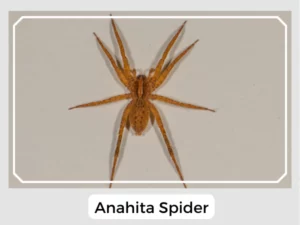The Anahita is a type of wandering spider. There are about 20 different kinds in this group! You can mostly find them in places like Asia and Africa. These spiders are pretty cool, and we’ve gathered some fun facts to tell you about them right in this post!

Photo Credit: David L. Heavner
The small-sized round eggs remain safely protected in a silken sac produced by the females.
The spiderlings stay for some time with their kin, and finally, upon maturation leave their family to thrive independently.
Like most other wandering spiders, species of this genus do not build webs but roam about in the ground at night to hunt their prey.
Yes, Anahita spiders have venom. They use it to help catch the bugs they eat. But for people, it’s not really worrying.
They can bite if they feel cornered. The bite might feel like a little pinch and swelling, but most people don’t find it too bothersome.
The Anahita spiders hold a vital position in the ecological balance of their habitats. By preying on small insects, they contribute to controlling pest populations and support the overall health of their ecosystems. Their nocturnal and wandering nature reflects a unique behavioral pattern that distinguishes them from other spider families.
Natural Predators: Despite their predatory nature, Anahita spiders are not exempt from threats. Birds, larger spiders, and various insect species count among their natural predators, forming a crucial part of the ecological balance within their environments.
Prey-Predator Dynamics: The life of an Anahita spider is a delicate dance within the complex web of nature. They serve as both predators and prey, demonstrating the complexity and balance of ecological interactions.
Relationship with Humans: First described by the German arachnologist Ferdinand Karsch in 1879, the Anahita genus has since been a subject of interest and study. Their presence across diverse regions highlights their adaptability and ecological significance.
| Distribution | USA, Burundi, Congo, Ivory Coast, China, Russia, and Egypt |
| Habitat | Forests |
| Diet | Small insects |
| Lifespan | 1-2 years |
In conclusion, the Anahita genus offers a fascinating glimpse into the life of wandering spiders, showcasing their unique traits, ecological significance, and intricate behavioral patterns.
The Anahita is a type of wandering spider. There are about 20 different kinds in this group! You can mostly find them in places like Asia and Africa. These spiders are pretty cool, and we’ve gathered some fun facts to tell you about them right in this post!

Photo Credit: David L. Heavner
The small-sized round eggs remain safely protected in a silken sac produced by the females.
The spiderlings stay for some time with their kin, and finally, upon maturation leave their family to thrive independently.
Like most other wandering spiders, species of this genus do not build webs but roam about in the ground at night to hunt their prey.
Yes, Anahita spiders have venom. They use it to help catch the bugs they eat. But for people, it’s not really worrying.
They can bite if they feel cornered. The bite might feel like a little pinch and swelling, but most people don’t find it too bothersome.
The Anahita spiders hold a vital position in the ecological balance of their habitats. By preying on small insects, they contribute to controlling pest populations and support the overall health of their ecosystems. Their nocturnal and wandering nature reflects a unique behavioral pattern that distinguishes them from other spider families.
Natural Predators: Despite their predatory nature, Anahita spiders are not exempt from threats. Birds, larger spiders, and various insect species count among their natural predators, forming a crucial part of the ecological balance within their environments.
Prey-Predator Dynamics: The life of an Anahita spider is a delicate dance within the complex web of nature. They serve as both predators and prey, demonstrating the complexity and balance of ecological interactions.
Relationship with Humans: First described by the German arachnologist Ferdinand Karsch in 1879, the Anahita genus has since been a subject of interest and study. Their presence across diverse regions highlights their adaptability and ecological significance.
| Distribution | USA, Burundi, Congo, Ivory Coast, China, Russia, and Egypt |
| Habitat | Forests |
| Diet | Small insects |
| Lifespan | 1-2 years |
In conclusion, the Anahita genus offers a fascinating glimpse into the life of wandering spiders, showcasing their unique traits, ecological significance, and intricate behavioral patterns.